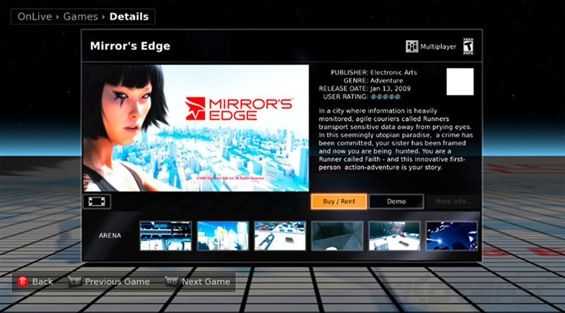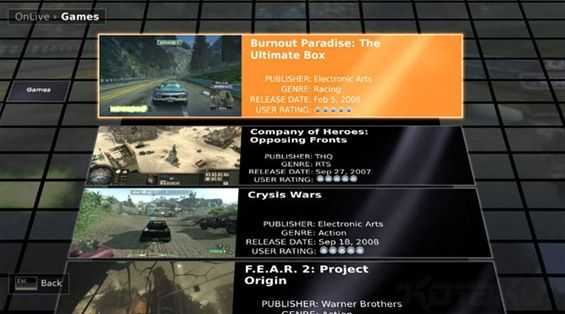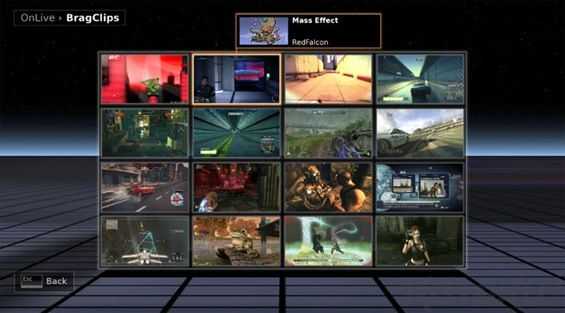 An interesting story over at Kotaku talks about a new service called OnLive. The vision of OnLive is to bring processing intensive gaming to low end hardware, a sort of on-demand gaming service.
An interesting story over at Kotaku talks about a new service called OnLive. The vision of OnLive is to bring processing intensive gaming to low end hardware, a sort of on-demand gaming service.
The way it works is essentially opening a video stream from the OnLive server to an OnLive client application on your computer. Your inputs would be sent to the server, and all of the game’s processing would happen on the server and the results would be streamed to your computer. The idea is actually not new, we told you about StreamMyGame back in June of 2008 which uses the same basic idea except you can use your own personal computer to act as the server. The idea was targeted toward those who already had expensive gaming computers, and could use StreamMyGame to play games on lower end hardware over their own network.
OnLive aims to bring high quality gaming to those with low-end hardware, without the need to own expensive equipment. By staging all of the processing on their own servers, the real bottleneck is not hardware performance, but instead, internet connection speed. OnLive says that full quality SD gaming can be achieved on a 1.5mbps connection, and 720p with a 5mbps connection. OnLive says that they are using patented technology to do the video compression, and say that games will play through their service at up to 60 frames per second. If there is any artifacting or lag in the streamed game video, OnLive will have a hard time convincing any hardcore gamers to use their service.
 Interestingly, the Kotaku article mentions that OnLive claims that their game video streams will have a ping of less than one millisecond. They also said that their patented video compression will take about one millisecond to complete as well. If true (and there aren’t any other lag points on the way) these times should mean that you will get nearly lag free gaming on any hardware that can play back the video stream, and has a fast enough internet connection. That category could include netbooks and lower end hardware like the MIDs and UMPCs that we cover here on ultra mobile PC Portal.
Interestingly, the Kotaku article mentions that OnLive claims that their game video streams will have a ping of less than one millisecond. They also said that their patented video compression will take about one millisecond to complete as well. If true (and there aren’t any other lag points on the way) these times should mean that you will get nearly lag free gaming on any hardware that can play back the video stream, and has a fast enough internet connection. That category could include netbooks and lower end hardware like the MIDs and UMPCs that we cover here on ultra mobile PC Portal.
So what would it really mean for people who like to play games but own netbooks? Obviously you would be able to play graphically complex games that your netbook would never be able to handle rendering on its own, but there are more benefits. This style of server-side gaming would mean not only no downloads, but no instillations of games either. Theoretically, this could mean being able to play a game like World of Warcraft, which currently consumes about 15GB of your HDD, on a device that has even less storage than the game itself requires for normal instillation. Not only would you be able to skip the 15GB download, but you wouldn’t need to wait for a long instillation session. Another advantage this has for netbook and other mobile hardware users is that on-demand gaming doesn’t require a CD/DVD drive. The majority of netbooks out there do not come with CD/DVD drives, and unless you want to play around with .ISO files, you are usually out of luck when it comes to installing games to your system. OnLive’s service would make an easy entry point for someone who doesn’t know how to mount an .ISO, but would still like to try some of the latest and greatest gaming.
 All of this sounds a little bit too good to be true right? Hopefully that isn’t the case. Kotaku says that they had a chance to test the service (albeit, in a controlled environment) and were able to play Crysis (a game known for bringing some gaming rigs to their knees) on a low spec machine. The OnLive service is still in internal beta, with an external beta test planned for this summer. We’ll keep an eye on OnLive and see how it all turns out.
All of this sounds a little bit too good to be true right? Hopefully that isn’t the case. Kotaku says that they had a chance to test the service (albeit, in a controlled environment) and were able to play Crysis (a game known for bringing some gaming rigs to their knees) on a low spec machine. The OnLive service is still in internal beta, with an external beta test planned for this summer. We’ll keep an eye on OnLive and see how it all turns out.
Quickly I want to also mention that OnLive plans on rolling out a small piece of hardware that one could use to have the OnLive gaming experience on their TV. The little box, probably not much larger than a 2.5 inch external HDD, could be hooked up to your HDTV via HDMI, and given a fast enough connection, play high end games in 720p on your TV. The unit is targeted to have a competitive price, possibly lower than that of the Wii.











New article: Will server-side computing turn our netbooks into gaming machines? http://cli.gs/BbmJpA
I have a feeling though that people into Netbooks, aren’t very largely gamers, they really don’t fit the specs of a gaming machine :)
As mentioned, the idea is not new. Ever since VLC supported screen streaming I used it together with Synergy to do that thing the freeware way. The problem however is latency – I have a powerful gaming htpc at om on a 10/10Mbit connection. The added sum of encoding, transmitting and decoding h264 to a 7Mbit cell-modem adds up to about 250ms which makes any fps unplayable. There are streaming solutions mentioned as “zero-latency” but so far I’ve not seen any good enough used for gaming.
The conclusion would be that if anyone wants to play demanding games, I believe that the netbooks will hold good enough mobile GPU for that purpose before anyone manage to implement a low bandwitdh, zero latency game streaming solution, but hopefully onlive will prove me wrong.
If the service is very light on the client side (ie. does the heavy computational work on the servers, and only does display/user-input on the netbook), then I bet it could work (pretty much what I said on Engadget yesterday). But, if not, then I think netbooks and MIDs might be underpowered. UMPC’s, which in my observation tend to have better-than-Atom CPUs, might do fine, though.
My other reservation is that, as you know, I don’t run Windows, anywhere. This service is projected to support Mac and Windows, but no announced support for Linux. Mac is great for me, I can run it on my desktops. But … since there isn’t a Mac netbook/MID/UMPC, that runs the desktop version of OS X, and since they haven’t announced Linux support … I think that leaves me out in the cold wrt to running this service on a netbook, MID, or UMPC.
I’m affectionate about both UMPC’s and gaming, and I believe a lot of gamers probably are too.
It’s not that I necessarily want to game while I’m on the go, but sometimes I do, and for that reason I have a nintendo DS, in spite of being a grown man.
A UMPC wouldn’t be my first, second, or even third system either. Of course, I’m not a typical user, and I can appreciate that, but my point is that the demographics are overlapping…and hardcore gamers with big gaming rigs do not necessarily have the expertise to rig a remote wake on lan setup to turn on their home computers while they’re on the go and activate their gaming remotely…
No, this is very interesting, I think…but why stop at gaming though?
I have to think that streaming of many other applications could be prefferable to storing them locally. Remote video transcoding comes to mind, but I’m sure there are others….combine it with a pay-as-you-go service and there could be a real benefit to it…
If someome discovers a way to send information in no time and not lightspeed at max, then i buy their story, and maybe the perpedo-mobile thing …. since then relax an laugh.
*prays for future when COD multiplayer can be played with just an Aigo MID and an HSPA connection*
The idea is great, especially for applications in general – for FPS-gaming though it will not work, unless they have some new really really great low latency streamed non-frame-based compression algorithm. Once again – try streaming anything using any codec through any open source solution such as VLC.
Will server-side computing turn our netbooks into gaming machines? http://v3.nu/USHAN/
Why not? Everything evolves.
Will server-side computing turn our netbooks into gaming machines? http://tinyurl.com/brllmj
I can tell that this is not the first time at all that you mention this topic. Why have you decided to write about it again?
I keep listening to the news speak about getting free online grant applications so I have been looking around for the best site to get one.
Will server-side computing turn our netbooks into gaming machines… http://tinyurl.com/ygzo7vr